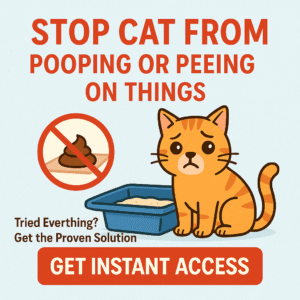If your cat seems constantly itchy, sneezing, or suffering digestive upset, they might be allergic—and that means tracking down the culprit is key. In this guide, we’ll break down the major allergens affecting cats, show how to identify them, and equip you with practical steps to relieve your feline friend—and yourself.
Plus, you’ll learn how the Cat Spray No More ebook supports structured routines, monitoring, and environmental adjustments—all essential for managing allergies effectively.
Five Major Allergy Types in Cats
Cats can react to several allergen categories, each triggering specific symptoms. Here’s a breakdown:
1. Flea Allergy Dermatitis (FAD)
Most common allergy in cats. Even a single flea bite can trigger intense itching, causing hair loss, scabs, and self-trauma—especially around the neck, base of tail, and thighs :contentReference[oaicite:0]{index=0}.
Signs to watch for: Constant grooming, chewing, or lesions—even without visible fleas.
Treatment: Use vet-recommended flea preventives year-round, treat the home environment, and possibly prescribe corticosteroids or antibiotics for flare-ups :contentReference[oaicite:1]{index=1}.
2. Food Allergies
Common triggers: Beef, chicken, fish, dairy; less frequent: wheat, corn, eggs, rabbit, lamb :contentReference[oaicite:2]{index=2}.
Symptoms: Ear infections, itchy skin, vomiting, diarrhea, or flatulence :contentReference[oaicite:3]{index=3}.
Diagnosis: 8–12 week elimination or hydrolyzed diet trial monitored by a vet :contentReference[oaicite:4]{index=4}.
3. Atopic Dermatitis (Environmental/Catlic)—Seasonal Allergies
Triggered by pollen, grass, weeds, molds, mildew, dust, and mites. These may be seasonal or year-round :contentReference[oaicite:5]{index=5}.
Symptoms: Itchy dermatitis, sneezing, coughing, wheezing, watery eyes :contentReference[oaicite:6]{index=6}.
Treatment: Skin tests or blood tests followed by allergy shots (immunotherapy), corticosteroids, fatty acids, or antihistamines :contentReference[oaicite:7]{index=7}.
4. Contact Allergies
These occur when cats touch irritants such as plastics (in bowls), wool, treated fabrics, flea collars, or cleaning products :contentReference[oaicite:8]{index=8}.
Signs: Localized skin irritation or acne, especially on the chin.
Solution: Remove the irritant and switch to hypoallergenic materials like ceramic bowls; treat affected skin as directed by your vet :contentReference[oaicite:9]{index=9}.
5. Drug & Insect/Environmental Allergens
Allergy to medications: Although rare, cats can react to vaccines, antibiotics, or topical flea products, causing hives, vomiting, or rarely anaphylaxis :contentReference[oaicite:10]{index=10}.
Other environmental allergens: Perfumes, smoke, household cleaners, treated surfaces—cats may fundraise respiratory or skin irritation :contentReference[oaicite:11]{index=11}.
Immediate action: Stop suspect products; contact your vet if severe signs appear.
How to Know If Your Cat Has an Allergy
Allergy symptoms in cats often include:
- Intense itching, hair loss, scabs, especially near ears and neck
- Respiratory issues: sneezing, coughing, wheezing
- Gastrointestinal upset: vomiting, diarrhea
- Skin inflammation or contact redness
- Recurring ear infections
Since symptoms often overlap, a vet visit is essential for proper diagnosis via physical exams, skin or blood tests, elimination diets, and parasite checks :contentReference[oaicite:12]{index=12}.
Step-by-Step Allergy Management Plan
1. Flea Control
- Use vet-approved preventative year-round
- Treat the entire environment (bedding, furniture, carpets)
- Monitor for signs and treat secondary infections
2. Elimination Diet Trial for Food Allergies
- Work with your vet on novel or hydrolyzed diet
- No treats or flavored meds during trial
- Monitor symptoms and confirm diagnosis before reintroducing foods
3. Manage Seasonal & Environmental Allergies
- Allergy testing leads to immunotherapy decisions
- Clean home environment: air purifiers, unscented litter, mold control
- Use supplements like omega‑3s for skin health
4. Avoid Contact Irritants
- Switch to ceramic/steel bowls; disinfect regularly
- Use gentle detergents and lightweight, natural fabrics
5. Monitor Medications & Reactions
- Be alert to side effects or swelling post-medication
- Consult your vet immediately if signs of anaphylaxis appear
How the Cat Spray No More eBook Supports Allergy Management
| Challenge | eBook Tools |
|---|---|
| Symptom tracking | Use logs to monitor itching, sneezing, eating habits |
| Routine building | Daily checklists help with medication, grooming, cleaning schedules |
| Environment control | Room-by-room guides for cleaning, replacing bowls, reducing triggers |
| Introduce changes stepwise | Supports gradual diet trials and environmental adjustments |
| Reward systems | Positive reinforcement for new routines or medication acceptance |
Real-Life Allergy Recovery Story
“Our cat Luna constantly scratched and developed ear infections. After flea prevention and a grain-free elimination diet, her symptoms improved—but still sneezing seasonally. We used allergy testing and now she’s on immunotherapy. Following the structure and logs from the Cat Spray No More ebook helped us stay consistent. Now, she’s calm, clean, and happy.”
When to Contact Your Veterinarian Immediately
- Severe itching, open sores, or constant scratching
- Respiratory distress (wheezing, difficulty breathing)
- Ongoing vomiting, diarrhea, or weight loss
- Anaphylaxis signs: facial swelling, collapse
Conclusion: You’re Not Alone—Help Is Here
Cat allergies range from flea bites to food, environmental, contact, and medicine reactions. Symptoms can overlap, so effective management starts with vet diagnosis and consistent routine care.
With the Cat Spray No More ebook, you gain daily tools—tracking, cleaning, feeding, and environment guides—to help your allergic cat stay comfortable.
Download Cat Spray No More now and empower yourself with structure, clarity, and confidence—together with allergen management strategies that truly make a difference.
